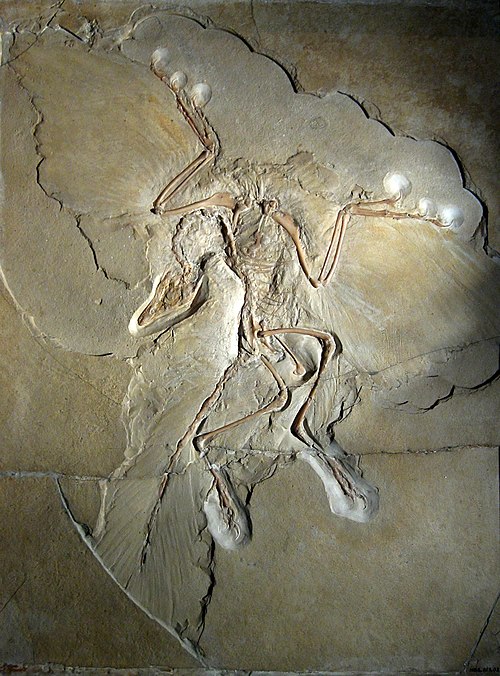Facts for Kids
Archaeopteryx is a significant prehistoric creature known as the earliest bird, showcasing features of both dinosaurs and modern birds, including feathers and a skeletal structure optimal for flight.
Overview
Conservation Status
Habitat And Behavior
Physical Characteristics
Discovery And Fossil Find
Evolutionary Significance
Comparison With Modern Birds
Scientific Research And Studies
Cultural Impact And Representation

Inside this Article
Combination
Limestone
Discovery
Interest
Dinosaur
Fossil
Earth
Time
Tail
Did you know?
🦖 Archaeopteryx is often considered the first known bird, living around 150 million years ago.
🌍 It lived during the late Jurassic period in what is now Germany.
🦅 Archaeopteryx had feathers similar to modern birds, indicating its strong link to avian species.
🔍 The first fossil of Archaeopteryx was discovered in 1861, making it a key discovery in the field of paleontology.
📏 It measured approximately 0.5 meters (1.6 feet) in length.
🦷 Archaeopteryx possessed teeth and a long bony tail, traits typical of reptiles.
📸 The fossilized remains of Archaeopteryx include well-preserved feathers, offering insights into early avian evolution.
🍽️ Evidence suggests that Archaeopteryx may have hunted small prey, similar to modern raptors.
👥 Archaeopteryx served as a transitional form between dinosaurs and birds, illustrating the evolution of flight.
🬖 Different specimens of Archaeopteryx show variation in feather characteristics, indicating possible adaptations.
Introduction
It lived about 150 million years ago during the Late Jurassic period. This remarkable creature is often called the "first bird." Why? Because it had both features of dinosaurs and birds! 🦖✈️ Archaeopteryx was found in Germany, specifically in a place called Solnhofen Limestone. The first fossil was discovered in 1861, amazing people who study dinosaurs and birds! Its name means "ancient wing." This creature helps scientists understand how birds grew from dinosaurs over millions of years! 🦅✨
Conservation Status
However, many modern birds need our help! 🐦
Their homes are being destroyed by human activities, making it important to protect the environment. This helps us remember the connection between ancient creatures like Archaeopteryx and the birds we see today. By caring for nature, we ensure that many amazing species continue to thrive! 🌍🌳 So let’s protect our planet and the lovely birds that fly above us, so they don’t become part of history like Archaeopteryx! 🌈
Habitat And Behavior
It is believed to have lived in a habitat similar to tropical forests today. This creature likely spent a lot of time in trees, where it could glide between branches and escape predators. 🦁
Scientists think it ate small animals, insects, and plants, similar to some birds today. Archaeopteryx may have also made nests in trees to lay its eggs! 🥚
Taking care of its young would have been important for survival in its forest home!
Physical Characteristics
It had long feathers on its wings, which would have helped it glide and fly. But, it also had sharp teeth, a long bony tail, and claws on its wings! 🦖
This combination of features shows us that it was not just a bird, but still had some dinosaur traits. Its wings had feathers that were similar to modern birds. Scientists believe that Archaeopteryx could flap its wings and may have been able to fly, but it could also run and climb trees just like some dinosaurs. 🌳✨
Discovery And Fossil Find
This fossil was important because it looked like a mix of a dinosaur and a bird! The fossils are found in Solnhofen, Germany, where the rocks are very old. So far, scientists have found 12 Archaeopteryx fossils! 🦴
One of the most famous fossils shows feathers that look like those on modern birds. Scientists continue to study these fossils to learn more about how birds evolved from dinosaurs. Can you imagine finding something over 150 million years old? That’s pretty cool! 🕵
️♂️💚
Evolutionary Significance
It shows a clear link between dinosaurs and modern birds, helping us understand how birds evolved over millions of years! This little creature has features from both groups, making it a "missing link." Scientists study its skeleton, feathers, and other traits to learn how flying evolved. 📚
Its discovery changed how we understand the relationship between reptiles and birds. By examining Archaeopteryx, we better understand how life has changed over time and how species adapt to their environment! 🌼
Comparison With Modern Birds
For example, it had sharp teeth like dinosaurs, while most birds today have beaks. 🦷
It also had a long tail, while most birds have shorter ones. However, both Archaeopteryx and today's birds have feathers! 🌈
Scientists believe that feathers helped Archaeopteryx fly or glide. Comparing these two helps us learn about how birds developed over millions of years! So next time you see a bird, think of its ancient cousin, Archaeopteryx! Fly high! 🕊
️✨
Scientific Research And Studies
They analyze the fossils using advanced technologies like X-ray imaging. This helps them see details inside the bones and feathers. By studying the fossils, scientists discover how it lived, what it ate, and how it moved! 🏃
♂️ Research also includes looking at its environment and changes over time. Books, articles, and museums showcase their findings, teaching others about this incredible creature! The ongoing studies of Archaeopteryx inspire new questions and discoveries about dinosaurs and birds every day! 🌟📖
Cultural Impact And Representation
This creature teaches us about our planet's history, reminding us how amazing nature can be! It helps create interest in science and learning about the past! 📚
Kids and adults alike are attracted to the mystery of how ancient creatures lived long ago. Archaeopteryx truly continues to capture our imaginations! 🤩

